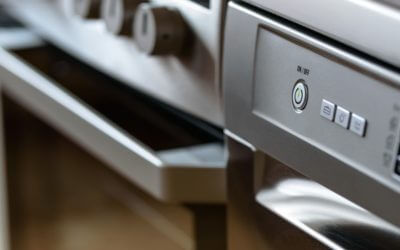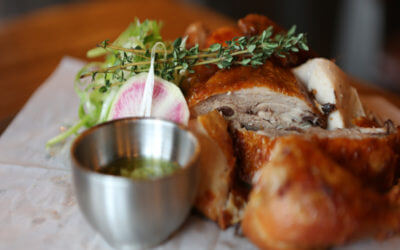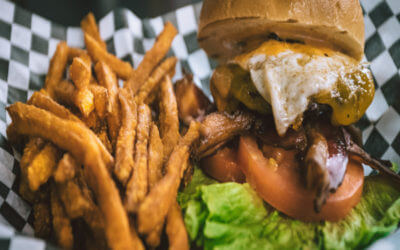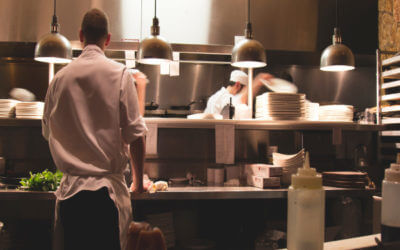5 Tips for an Ergonomically Sound Restaurant
June 1, 2017The physical environment of your restaurant should not only be appealing to customers but also be comfortable and safe for your employees.
Due to the repetitive motions that characterize the job description of restaurant employees, there is a potential for musculoskeletal injuries. Ergonomics is the practice of providing a work environment that minimizes the risk of such injuries. To make an ergonomically sound restaurant for your employees, consider implementing the following.
- Ergonomically Sound Restaurant Tip: Use Push Carts for Serving
Tray carrying can cause pain in the arms and wrists. As much as possible, reduce tray carrying and use carts instead. Arrange the interior of your restaurant in such a way to allow easy movement of carts. If you choose not to use carts, teach your servers to use both hands to carry plates and trays. Whenever large parties are to be served, more hands should be involved. These measures will help prevent straining of the wrists.
- Ergonomically Sound Restaurant Tip: Provide Anti-Fatigue Mats
To prevent discomfort and fatigue of employees’ feet, legs and lower back, providing anti-fatigue mats in areas where employees stand for long periods of time. You should also consider padded floors, especially in the kitchen, where most tasks are done while standing. Softer surfaces will take some of the pressure off employees’ feet, reducing discomfort and injuries.
- Ergonomically Sound Restaurant Tip: Make Cushioned Insoles Mandatory
Any employee on duty should be required to wear shoes with cushioned insoles. This will reduce the occurrence of the foot and leg pain that is common with repetitive standing movements. If possible, shoes should be provided to increase compliance with your restaurant’s footwear policy.
- Ergonomically Sound Restaurant Tip: Use Knives the Right Way
Dull-edged knives make it necessary for your cooks to use extra force when cutting foods. This adds to the physical strain of knife usage. Kitchen knives should be sharpened often to prevent unnecessary use of force. Also instruct your kitchen staff to use the appropriate knives for the type of food they are cutting, and to never cut foods without using a cutting board.
- Ergonomically Sound Restaurant Tip: Encourage healthy behaviors
Encourage your employees to take care of their musculoskeletal system by drinking enough water. They should also be provided with mandatory stretch breaks. A restaurant can be a fast-paced and exhausting environment, but encouraging regular exercise outside of work can keep employees more physically fit and help their bodies withstand the pressures of the job.
As a restaurant owner, it is your responsibility to ensure the safety of your employees. In addition to providing the proper equipment and restaurant design to reduce ergonomic sound restaurant issues and safety hazards, proper training on work organization, safe performance of tasks and handling of emergency situations should be provided. Proper ergonomics will have your employees performing at their best and reduce absences and injury lawsuits. It is an investment well worth making.
What’s in a Cooking Pot, How to Choose the Right One?
As a restaurant owner, your cooking needs might vary. Did you know that a good quality pot can greatly improve your cooking experience, while also improving the quality of your cooking? This cooking equipment is a very important one that cannot be done away with...
5 Things Every Restaurant Owner Should Do Before Buying Used Kitchen Equipment
Equipping your restaurant properly can cost a lot of money, so buying used kitchen equipment is the go-to choice for many restaurateurs. Buying used kitchen equipment for a restaurant is a bit different than buying used equipment for your home, however. You will...
Top Restaurant Technology Trends in 2018
When looking to buy restaurant supplies, you want to be on the leading edge of technology trends. This will keep your kitchen running smoothly. Let’s take a look at some of the most recent trends in restaurant supplies technology. 1. New Payment Options Who would...
5 Different Ice Shapes and Why You Should Care About Them
Ice makers are very popular in the restaurant and foodservice community because they eliminate the need to buy ice every day. And of course, adding an ice maker to your collection of foodservice equipment means you will always have ice on hand when you need it. An...
Pulping and Grinding: A Starter’s Guide to Reducing Commercial Food Waste Costs
For most restaurant owners and managers, the expenses involved in making meals are always under careful consideration. Water is needed to prepare, cook and wash food; power is necessary for food prep, cooking and cooling, and so on. However, how many of us consider...
Choosing the Right Milk Cooler: Cold Wall or Forced Air?
In a restaurant, milk is an essential to have on hand for coffee and other café-style beverages, for serving with kids’ meals, and as a key ingredient in many recipes. Keeping your milk properly chilled can be difficult without the proper restaurant equipment....
How to Choose Your Next Commercial Meat Smoker
The movies that connect with us on a personal level are the ones that linger in our memories forever. Anyone who has used a commercial meat smoker knows that they have a huge influence on the taste of a meal. You need to have just the right kitchen equipment to get a...
Are High Speed Ovens Too Good to be True?
You might have heard a few of the bold claims that foodservice equipment manufacturers have been making about high speed ovens, but they can’t be possible, right? Cooking three times as faster as regular ovens? Five times as fast? Fifteen times as fast? It may seem...
Choosing the Right Food Storage Containers for Your Restaurant
Choosing the right kitchen supplies will make a difference in your restaurant. Whether it is heavy duty kitchen equipment or food storage containers, each piece of equipment plays its own important role. Today, we are going to talk about how to choose the right food...
Tipton’s Guide to Perfect Poultry Trussing
Do you ever truss birds in your commercial kitchen? Trussing is a fantastic cooking technique because it makes poultry cook faster, look more attractive and taste better. If your commercial kitchen prepares poultry, you don’t want to miss these trussing tips. Trussing...
How to Eliminate Excess Condensation in Your Kitchen
Is your commercial kitchen getting steamy? If so, you could have more than just an uncomfortable working environment on your hands. Excess moisture in your commercial kitchen can result in the corrosion of equipment, the development of mold, and even damage to your...
The DIY Guide to Your Restaurant’s Own Garden
Stocking your restaurant supply with your own home-grown herbs and produce can truly bring your dishes to life. When it comes to food, everyone knows there’s nothing like homemade and home-grown. Having your own culinary garden, however large or small, can help you...
5 Reasons a Meat Grinder Will Set Your Burgers Apart
The more you do to prepare your foods in-house with the right kitchen equipment, the fresher and more flavorful your dishes become. There are all sorts of restaurants offering fast-food style burgers, but some diners are looking for the real deal. A fresh, juicy...
Pest Preventions to Implement in Your Commercial Kitchen
Restaurant pests: it’s something that few people want to think about. Like it or not, pest management is an essential consideration for every commercial kitchen. Offering food, shelter and water, the unprepared commercial kitchen naturally provides everything pests...
Choosing the Right Material for Your Cooking Equipment
Kitchens are very unique to their chef. Just like a car mechanic has a toolbox unique to them, so is the cooking equipment in a kitchen. And over time, the same cooking equipment become a natural extension of the chef. What tools are you using in your kitchen? It...















